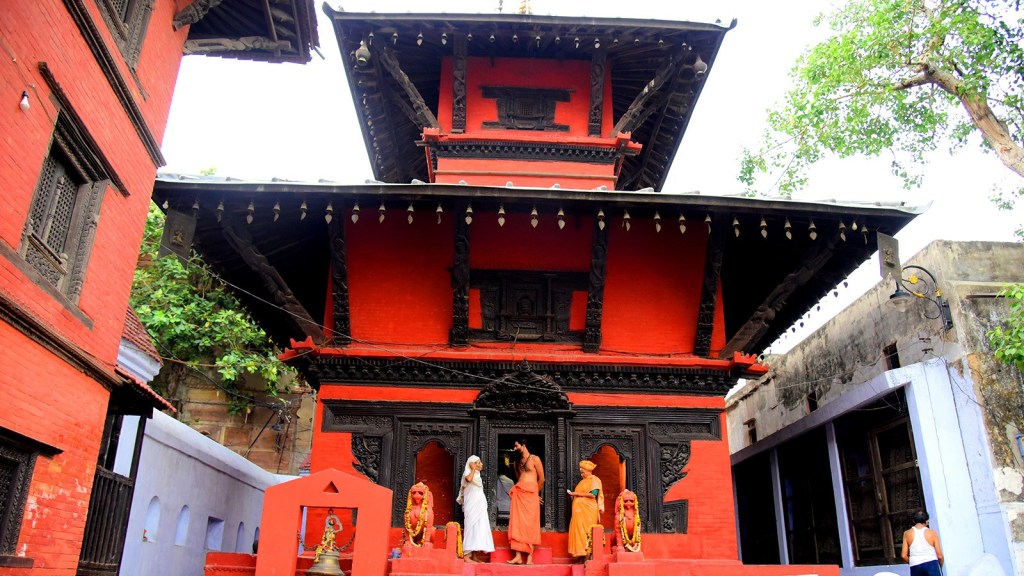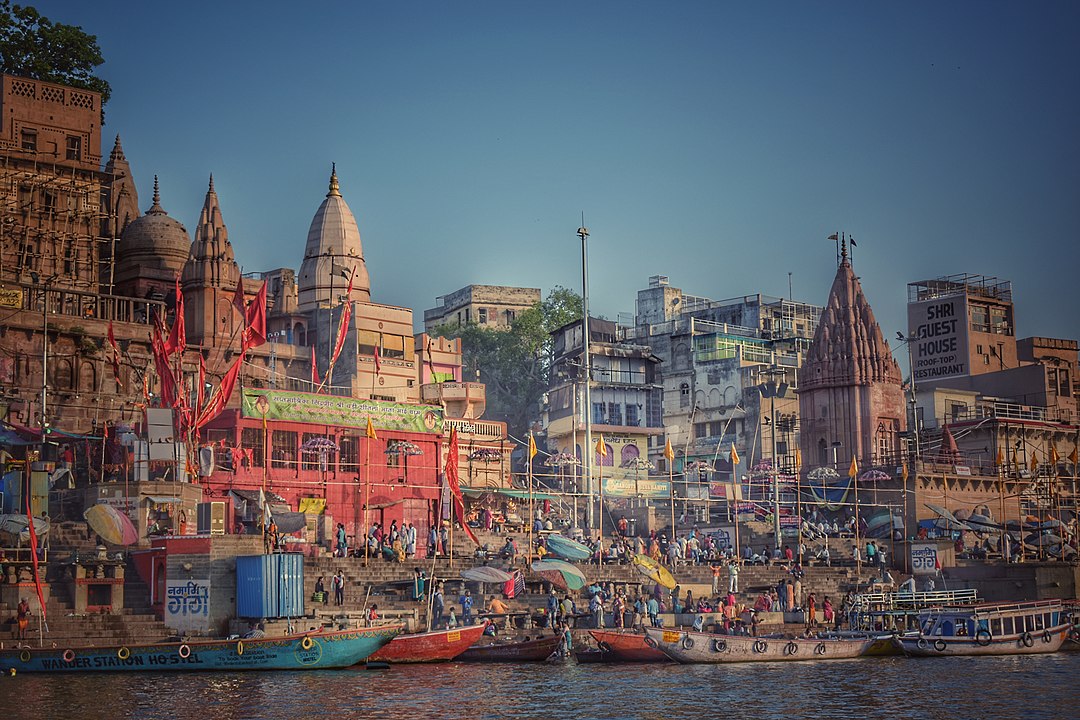
The Kathwala Temple, also known as the Nepali Mandir, is situated in the heart of Varanasi, one of the oldest continuously inhabited cities in the world and a major pilgrimage site for Hindus. Specifically, the temple is located in the Lalita Ghat area of Varanasi, which is renowned for its spiritual significance and vibrant atmosphere. Lalita Ghat lies along the western bank of the sacred Ganges River, where devotees gather to perform rituals, take holy dips, and partake in religious ceremonies.
History of Nepali Kathwala Temple Varanasi
The Kathwala Temple, also known as the Nepali Mandir, is a sacred edifice nestled within the ancient streets of Varanasi, the spiritual heart of India. Its history dates back to the 19th century when Rana Bahadur Shah, the King of Nepal, embarked on a pilgrimage to Varanasi, seeking divine blessings from Lord Shiva. Inspired by his spiritual journey, the king resolved to build a temple dedicated to Lord Shiva in Varanasi as an expression of gratitude for the divine grace he received.
The construction of the Kathwala Temple was a monumental undertaking, driven by the king’s deep devotion and reverence for Lord Shiva. Skilled Nepalese artisans were commissioned to bring the king’s vision to life, resulting in a masterpiece of architectural brilliance. The temple’s design is a harmonious blend of Nepalese and North Indian architectural styles, characterized by intricate wood carvings, ornate motifs, and tiered pagoda-like structures that stand as a testament to the craftsmanship of the artisans.
Since its inception, the Kathwala Temple has served as a sacred pilgrimage site for devotees from Nepal and India, drawn to its hallowed sanctum dedicated to Lord Shiva. The temple’s main sanctum houses a revered Shivalinga, the sacred symbol of Lord Shiva, where devotees offer prayers and seek blessings with unwavering devotion. Over the centuries, the temple has witnessed the ebb and flow of history, yet its spiritual significance remains undiminished, continuing to inspire awe and reverence among pilgrims and tourists alike. As a symbol of cultural exchange and religious harmony, the Kathwala Temple stands as a timeless monument to the enduring bond between Nepal and India, inviting visitors to embark on a journey of spiritual enlightenment and divine grace.
Architectural Details of Kathwala Temple
The Kathwala Mandir, also known as the Nepali Mandir, holds immense architectural importance as a striking example of cultural fusion and craftsmanship. Built in the 19th century under the patronage of the King of Nepal, Rana Bahadur Shah, this temple in Varanasi stands as a remarkable blend of Nepalese and North Indian architectural styles.
At first glance, the Kathwala Mandir captivates with its majestic pagoda-like structure, characterized by tiered roofs, ornate spires, and intricate wood carvings. The temple’s façade is adorned with a profusion of elaborate motifs, Including mythological scenes, celestial beings, and floral patterns, each intricately carved by skilled artisans. These exquisite carvings not only showcase the mastery of Nepalese craftsmanship but also reflect the rich symbolism and spiritual significance inherent in Hindu mythology.
Beyond its exterior beauty, the Kathwala Mandir boasts a meticulously designed interior that is equally awe-inspiring. The temple’s sanctum sanctorum houses a revered Shivalinga, the sacred symbol of Lord Shiva, where devotees offer prayers and perform rituals with utmost reverence. The sanctum is adorned with ornamental pillars, decorative arches, and finely crafted altars, creating a serene and divine ambiance conducive to spiritual contemplation and worship.
Moreover, the architectural layout of the Kathwala Mandir is designed to evoke a sense of transcendence and connection with the divine. The temple’s layout follows the principles of sacred geometry, with precise measurements and proportions that align with Vastu Shastra, the traditional Hindu system of architecture. This sacred geometry is believed to harmonize the energy flow within the temple, creating a conducive environment for spiritual practices and rituals.
Overall, the Kathwala Mandir stands as a testament to the architectural ingenuity and artistic expression of its creators. Its harmonious blend of Nepalese and North Indian styles, coupled with its intricate craftsmanship and spiritual symbolism, elevates it to a place of profound architectural importance within the sacred landscape of Varanasi. As a timeless monument to devotion and cultural exchange, the Kathwala Mandir continues to inspire awe and reverence among all who behold its splendour.
Images of Nepali Kathwala Temple Varanasi
Importance of Kathwala Mandir for Varanasi
Architectural Diversity:
Unique Structure: The wooden architecture of Kathwala Mandir distinguishes it from the predominantly stone-built temples in Varanasi. This uniqueness enhances the city’s architectural diversity, adding to its aesthetic and historical richness.
Craftsmanship Showcase: The intricate woodwork highlights the skill of artisans, contributing to Varanasi’s reputation as a center of artistic excellence.
Cultural Heritage:
Tourist Attraction: The temple attracts tourists, boosting local tourism and contributing to the economy. It adds to the allure of Varanasi, which is already a major pilgrimage and tourist destination.
Cultural Preservation: Kathwala Mandir helps in preserving traditional art forms and architectural styles, which are an integral part of the city’s cultural heritage.
Religious Significance:
Place of Worship: As a temple dedicated to Lord Shiva, it serves as a vital religious site for local devotees, reinforcing Varanasi’s identity as a spiritual hub.
Festivals and Rituals: The temple is a focal point during religious festivals like Maha Shivaratri, enhancing the communal and religious life of the city.
Educational Value:
Learning Resource: For scholars and students, the temple offers insights into the integration of different architectural styles and the religious practices of Varanasi.
Importance for Nepal
Cultural and Religious Ties:
Historical Connections: The temple is believed to have been built by a Nepali king or under the influence of Nepali artisans, reflecting historical ties between Nepal and Varanasi. This connection highlights the cultural and religious exchanges between the two regions.
Pilgrimage Destination: For Nepali devotees, Kathwala Mandir is a significant pilgrimage site, strengthening the spiritual bond between Nepal and Varanasi.
Architectural Influence:
Nepali Artisanship: The temple’s architecture is a fine example of Nepali woodwork and craftsmanship. It showcases the influence of Nepali artisans and their contribution to the cultural heritage of Varanasi.
Symbol of Pride: The presence of a Nepali-influenced temple in Varanasi serves as a symbol of cultural pride for Nepalis, reflecting their historical and cultural footprint in one of Hinduism’s most sacred cities.
Cultural Diplomacy:
Bilateral Relations: Kathwala Mandir can be seen as a cultural bridge between Nepal and India, promoting mutual respect and understanding. It serves as a testament to the longstanding cultural and religious relations between the two countries.
Tourism Exchange: The temple encourages tourism exchanges, with Nepali tourists visiting Varanasi to connect with their cultural and religious heritage, thereby fostering people-to-people connections.
Directions to Nepali Kathwala Temple Varanasi
A. From the City Center (Godowlia)
- Head towards the Manikarnika Ghat Kathwala Mandir is located close to this ghat.
- It’s advisable to walk or take a cycle rickshaw from Godowlia as the lanes are narrow and often congested with traffic.
B. From Assi Ghat
- Travel along the ghats (riverfront steps leading down to the Ganges River) towards Manikarnika Ghat.
- Walking along the ghats can be a scenic and spiritual experience, offering views of various temples and rituals along the way.
Timing to Visit Kathwala Mandir Varanasi
04:00 am to 12:00 noon and 1:00 pm to 09:00 pm; every day.
Nepali Kathwala Temple Varanasi Entry Fee
The Nepali Kathwala Temple, located in Varanasi, India, is known for its unique architecture and cultural significance. The good news for visitors is that there is no entry fee to visit the temple. This allows travelers and devotees to explore and appreciate the beauty and tranquility of this sacred place without any cost. Enjoy your visit!
Best Time to Visit Nepali Kathwala Temple Varanasi
Determining the best time to visit the Nepali Kathwala Temple in Varanasi depends on your preferences and what you hope to experience.
However, here are some considerations:
- Weather: Varanasi experiences extreme weather conditions, with hot summers and chilly winters. The best time to visit in terms of weather is during the cooler months, from October to March. The temperatures are more comfortable for exploring the temple and its surroundings.
- Festivals and Events: Varanasi is renowned for its festivals and cultural events. If you want to experience the temple amidst vibrant celebrations, consider visiting during festivals like Diwali, Holi, or Maha Shivaratri. These times offer a unique insight into the local culture and traditions.
- Crowds: Varanasi is a popular tourist destination and can get crowded, especially during peak seasons and festivals. If you prefer a quieter experience with fewer crowds, consider visiting during the off-peak months, such as July and August. However, be mindful of the monsoon season during these months, as it may affect travel plans.
- Time of Day: Early mornings and late evenings are generally quieter times to visit the temple, offering a more peaceful and serene atmosphere for prayer and reflection. Plus, you can witness mesmerizing rituals like the Ganga Aarti along the ghats during these times.
Overall, the best time to visit the Nepali Kathwala Temple in Varanasi is during the cooler months of October to March, preferably during festivals or in the early morning or late evening to avoid crowds and experience the temple’s tranquility.
How to Reach Nepali Kathwala Temple Varanasi
Reaching the Nepali Kathwala Temple in Varanasi is relatively straightforward, and there are various transportation options available depending on your location and preferences.
Here’s how you can reach the temple:
- By Air: The nearest airport to Varanasi is Lal Bahadur Shastri International Airport, located about 25 kilometres away from the city center. From the airport, you can hire a taxi or use app-based cab services to reach the Nepali Kathwala Temple.
- By Train: Varanasi Junction (also known as Varanasi Cantt) is the main railway station serving Varanasi and is well-connected to major cities across India. From the railway station, you can hire a taxi, auto-rickshaw, or cycle-rickshaw to reach the temple. Alternatively, you can use public buses or app-based cab services.
- By Road: Varanasi is well-connected by road, and you can reach the city via national highways and state highways. If you’re coming from nearby cities or towns, you can use state-run buses, private buses, or hire a taxi to reach Varanasi. Once you’re in Varanasi, you can reach the Nepali Kathwala Temple by hiring a taxi, auto-rickshaw, or cycle-rickshaw.
- Local Transportation: Within Varanasi, you can use auto-rickshaws, cycle-rickshaws, taxis, or app-based cab services to navigate the city and reach the Nepali Kathwala Temple. Varanasi’s narrow lanes and alleys may not always be accessible by larger vehicles, so auto-rickshaws and cycle-rickshaws are often preferred for short distances.
- Walking: Depending on your location in Varanasi, you may also consider walking to the Nepali Kathwala Temple if it’s within a reasonable distance. Walking through the city’s narrow lanes and bustling streets can be a memorable experience and allows you to soak in the local atmosphere.
Before traveling, it’s advisable to check for any travel advisories or restrictions, especially during peak seasons or festivals. Additionally, consider using navigation apps or seeking assistance from locals for directions to ensure a smooth journey to the Nepali Kathwala Temple in Varanasi.
Location of Nepali Kathwala Temple Varanasi
FAQs about the Nepali Kathwala Temple in Varanasi
What are the temple's opening hours?
The Nepali Kathwala Temple is typically open to visitors from early morning until late evening. However, specific opening hours may vary, so it's advisable to confirm the timings locally before planning your visit.
Is there an entry fee to visit the Nepali Kathwala Temple?
No, there is no entry fee to visit the Nepali Kathwala Temple. Visitors can explore the temple and its surroundings free of charge.
What is the best time to visit the Nepali Kathwala Temple?
The best time to visit the Nepali Kathwala Temple is during the cooler months of October to March when the weather is more comfortable. Additionally, visiting during festivals or early mornings/late evenings can provide a unique and peaceful experience.
How can I reach the Nepali Kathwala Temple in Varanasi?
The temple is accessible by various means of transportation. Visitors can reach Varanasi by air, train, or road, and then hire a taxi, auto-rickshaw, or cycle-rickshaw to reach the temple. Additionally, walking may be an option if the temple is within a reasonable distance from your location in Varanasi.
Are there any nearby attractions to visit along with the Nepali Kathwala Temple?
Yes, Varanasi is a city rich in culture and history, with numerous attractions to explore. Nearby attractions include other temples, ghats along the Ganges River, Sarnath (the birthplace of Buddhism), and the Banaras Hindu University.
Can I take photographs inside the Nepali Kathwala Temple?
Photography policies may vary, but generally, taking photographs inside the temple may be allowed. However, it's advisable to respect any signage or instructions provided by temple authorities and to be mindful of other visitors' privacy and religious sentiments.
Are there any specific dress code or guidelines to follow when visiting the temple?
While there may not be a strict dress code, it's advisable to dress modestly and respectfully when visiting religious sites in India. Avoid wearing revealing clothing and consider covering your head as a sign of respect, especially when entering the main sanctum of the temple.
Can I participate in rituals or prayers at the Nepali Kathwala Temple?
Yes, visitors are usually welcome to participate in rituals and prayers at the temple. However, it's recommended to observe and follow the lead of the temple priests and local devotees to ensure respectful participation.
Is the Nepali Kathwala Temple wheelchair accessible?
Accessibility may vary, but generally, the temple may not be fully wheelchair accessible due to its historical architecture and narrow pathways. However, visitors with mobility issues can inquire locally about accessibility options and assistance available at the temple.










